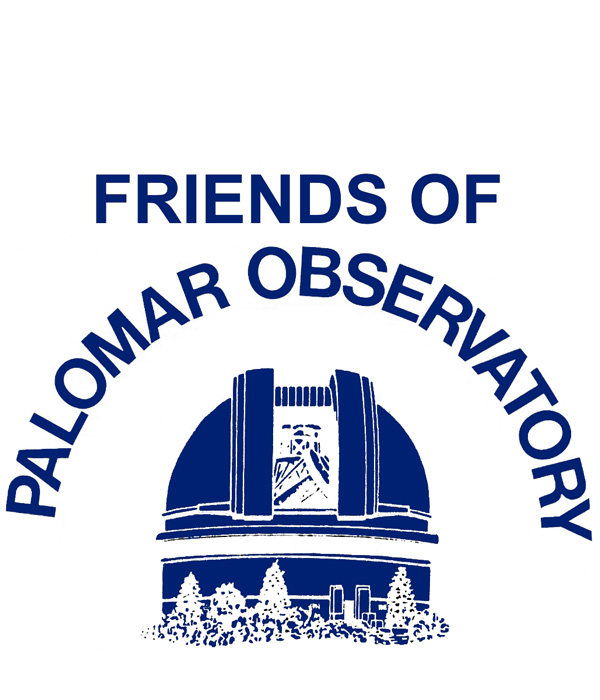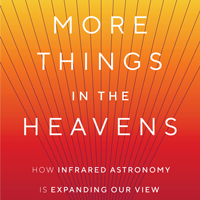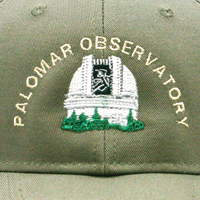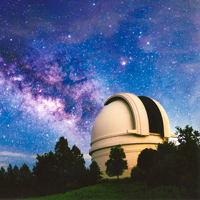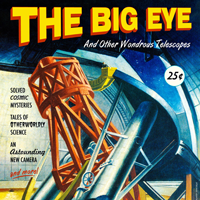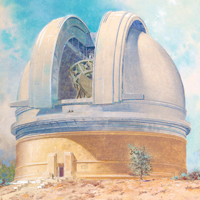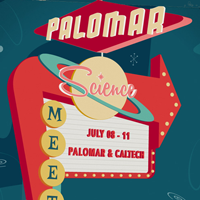Friends of Palomar Observatory Website
Upcoming Events

The Newsletter of the Friends of Palomar Observatory, Vol. 15 No. 2 – December 2020
The All New Palomar Observatory Gift and Book Store
Promotional video for the new online store. (Palomar Observatory/Caltech)
We are excited to share that the Palomar Observatory Gift and Book Store is online at store.palomar.caltech.edu. For many years the gift store in the Observatory’s Greenway Center has offered Palomar and astronomy-themed merchandise for our visitors, astronomers, and staff. Updating the gift store in a modern e-commerce context will greatly enhance our ability to serve Palomar enthusiasts near and far with a variety of apparel, books, graphics, and gifts. So if you’re like us and your favorite Palomar logowear is looking a bit worn and in need of replacement, check out the online store and order new merchandise and gifts for yourself and all the astronomy enthusiasts in your life.
Palomar Pandemic Operations
By Andy Boden
Contemplating the end of a turbulent 2020 I suspect that many of us share a sense of heightened fragility in our difficult times of continuing pandemic, civil unrest, and political turmoil. Many in our world have suffered greatly in these times, and our hearts go out to them. Even from my own fortunate perspective of relative safety, much of the routine we had grown accustomed to in our lives has been displaced by uncertainty and challenge to accommodate new and still evolving realities in our world.
Palomar has seen its share of challenges this year. As I wrote in the spring newsletter, we suspended Hale Telescope operations mid-March, but as many of you may know we were able to resume reduced operations in late May. My topic today is to report on the many efforts made by the observatory community in general and the staff in particular to resume Hale operations and discovery at Palomar.
When Hale operations resumed in May we did so cautiously at reduced duty factor (four nights on/three nights off) and with a single instrument set: the facility optical spectrograph (DBSP) at the telescope Cassegrain focus, and the near-IR imaging camera (WIRC) at prime focus. In typical times instruments are changed at one or both of these foci every few days, driven by the diverse Hale science portfolio. But in pandemic conditions the safety imperative is paramount, and careful attention to proper social distancing in the Palomar environment became our new guiding principle. As better understanding of COVID-safe protocols emerged we were gradually able to increase the duty factor (five on/two off) and add instruments to the available set: CHIMERA and WaSP and NESSI have been added at prime focus, and TripleSpec and most recently the facility adaptive optics (AO) system and the diffraction-limited near-IR imaging camera (PHARO) are now available at Cassegrain. As I write this I am excited to report that we have just completed our first successful extended AO run; the installation of the complex AO system posed particularly difficult distancing issues to think and work through. Each step in this progression of increasing science capability required us to reassess our operating procedures to emphasize safety over efficiency, and balance the demands of science programs with staff protection. We are very proud of our observatory staff led by Site Superintendent Rick Burruss for how they have reimagined Palomar operations to restore Hale observations and meet the safety challenges posed by the pandemic.
At the same time, pandemic realities have changed how we schedule Hale science observations. In normal times we go through telescope time allocation cycles twice yearly, and the schedules are set six months at a time and infrequently changed. But first the March operations suspension, and then reduced duty factor and instrument availability when operations resumed forced us to abandon this typical scheduling model and reimagine how we bring science programs to the Hale. Hopeful of adding increasing science capability over time, we adopted an ad-hoc, month-by-month scheduling model in May that could adapt to evolving operations capabilities. This has been my role: interfacing with our Hale science partner contacts at the Jet Propulsion Laboratory (JPL), Yale University, and National Optical Observatories of China (NAOC) to schedule programs that are the best match between partner priorities and evolving operations capabilities on the telescope. We are very grateful to our Hale partner contacts (Marla Geha at Yale, Sophia Dai at NAOC, and Mike Werner at JPL) who have extensively coordinated with me every few weeks to make sure that all our constituencies' interests remain fairly represented. While I do look forward to the time when we can revert to our traditional scheduling construct, for now I am satisfied that we are doing our best to responsibly manage the important telescope time resource entrusted to us.
Finally our astronomer community has had to adapt to new realities using the Hale for their research. The observatory remains closed to all outside personnel (except under carefully controlled circumstances—I myself have not been back to Palomar since February). So all Hale observations are now conducted remotely, with only the telescope operator in the data room, and both researchers and support astronomers connecting to instruments and videoconference remotely. Further, with our own Caltech campus remote observing rooms largely closed most of these observing sessions are being conducted from alternate locations such as home. We jokingly call this construct “pajama observing,” but it acknowledges a new reality as the pandemic grinds on into its second year. I know I speak for my colleagues when I say that we all greatly miss traveling to Palomar, staying at the Monastery, being in the wondrous Hale dome, and seeing our friends in person...
In addition to these operational adaptations to pandemic challenges, the observatory compound closure necessitated significant modifications to the Palomar public engagement program. In a companion article to this one my colleague Steve Flanders will describe our 2020 pandemic public outreach strategies.
Faced with the challenges of resuming Hale operations during pandemic conditions, the observatory community has come together to support both safety and discovery. Truly everyone has had to find new ways to keep the observatory productive while keeping our colleagues safe, and it has been wonderful to see the spirit of commitment and ingenuity to address the issues that arise one by one. Still, we are reminded of the many wonderful times spent at Palomar with our friends and colleagues, and look forward to a time—hopefully soon—when we can all be together there again.
Wishing you all health, safety, and every happiness in the forthcoming holiday season.
-Andy
The Greenway Series: Palomar Outreach Now Offers Online Talks and Virtual Tours
By Steve Flanders
With the pandemic gaining strength, Palomar Observatory temporarily closed to visitors in mid- March of 2020. With that closing, we suspended two key elements of the public outreach program, our tours in the dome of the Hale Telescope and our weekly lecture series, the Greenway Talks.
The public tours have been very popular. Offered on weekends from April to October, each year, these docent guided tours have given 5,000 or more people the opportunity to stand under the 200-inch telescope while learning about its history, engineering and science. In addition, we have provided tours to high school science classes, scout groups and similar organizations.
The Greenway Talks Series has also been well received. During the “off-season” when the public tours were not taking place, this program brought a succession of respected research scientists to Palomar Observatory. Addressing audiences of 50 or more people, the Greenway presenters spoke of the work being done on the most pressing and interesting questions of concern to professional astronomers and astrophysicists world-wide.
When these programs were put on hold in March, we set to work making up for the loss. Fortunately, we had in place one important offering. For some time, Palomar Observatory has maintained on our website a self-guided virtual tour of the facilities. This virtual tour allows our “virtual guests” to visit the Observatory at their convenience and at their own pace. A full description of our self-guided virtual tour may be found in the May 2020 edition of The Big Eye.
However, the self-guided tours lack a significant element of the real tours, the give-and-take questioning and spontaneous discussions that our guests enjoyed on tours guided by the volunteer docents. With this in mind, we are now able to offer Virtual Narrated Tours of the 200-inch Hale Telescope guided by the Observatory docents. In this program, we:
- Cover the same material ordinarily presented during an in-person tour in the dome;
- Allow for audience discussions with a docent tour guide; and,
- In a virtual setting, simulate as closely as possible the experience of our long-standing guided tour program.
The Virtual Narrated Tours bring the content of the self-guided virtual tour described above into a Zoom meeting. These tours are “narrated” in the sense that an Observatory docent joins each Zoom session and conducts the audience on a “virtual walk” through the Hale Dome. Moving from one location to the next, questions and discussion points are encouraged.
Each tour is set up in response to a specific request and is scheduled for a date and time specified by the requesting organization. The Virtual Narrated Tours are available at no cost to civic groups—libraries, service organizations, astronomy clubs and the like. We are especially interested in providing this service to student groups at the high school level and above. Our student-centered virtual educational tours emphasize the engineering and science of Palomar Observatory and conclude with discussions of career paths in astronomy and astrophysics.
Although business hours are preferred and two weeks advance notice is required, we have a good deal of flexibility in scheduling these events. For more information and to make an appointment, contact me at flanders [at] caltech.edu.
Spitzer's Final Voyage: Greenway presentation by Caltech-IPAC scientist Luisa Rebull, 7 Nov 2020.
Finally, with the Observatory’s closure, the Greenway Talks Series was also put on hold. So, we have again turned to Zoom and have now established a bi-weekly lecture series called the Greenway Talks Online.
This new series takes the basic concept of the old Greenway talks and brings it online. As before, respected astronomers and astrophysicists present their work and engage in discussions with the audience. Just as the “live” presentations were held on Saturday mornings, now the Zoom meetings are scheduled for Saturday mornings at 11:00AM. And just as in the past, everyone is welcome to attend.
Even so, there are some major differences between the Greenway Talks Online and the program we were offering before March of this year. Where formerly the talks were offered every week and only in the winter months, the Greenway Talks Online is now a bi-weekly series that will continue at least through the end of the pandemic. However, of all the changes, the physical separation of the participants may be the most obvious and important.
Another major change involves the steps needed to join a meeting and participate in one of these talks. Previously, while announcements were sent to FOPO members, many people attending our lectures simply dropped in to the Museum while touring the Observatory.
Drop in attendance is no longer possible—a Zoom invitation is required to join a presentation. FOPO members automatically receive invitations a week before an event. But for others, there is a two-step process: First, check the Greenway schedule of events on our website. Second, for an event you wish to attend, write to me at flanders [at] caltech.edu and request an invitation. As long as the request is not sent the day of the talk, I’ll return the invitation in time for the presentation.
If an event is missed, all of the Greenway presentations since this past spring are available on Palomar Observatory’s YouTube channel.
NSF Support Success
By Andy Boden
Palomar Observatory is excited to report that a number of new and/or recurring initiatives have been successful in obtaining National Science Foundation (NSF) support in the most current round of awards.
First we are excited to advise that the Zwicky Transient Facility (ZTF) will be supported by the NSF Mid-Scale Innovations Program (MSIP) for a second phase of operation, again under the leadership of Shri Kulkarni. ZTF saw first light in 2017 with a custom 600-Mpix camera, operates on the Samuel Oschin Telescope and the Palomar 60-inch telescope, and uses the Hale and other large telescopes for transient event follow up.
Next we are excited to announce that the new Hale Telescope facility optical spectrograph concept, the Next Generation Palomar Spectrograph (NGPS), received NSF development support. The proposal effort was led by Evan Kirby, and was selected for funding by the NSF Major Research Instrumentation (MRI) program. NGPS is envisioned as a replacement for the venerable facility Double Spectrograph, and is being jointly developed by Caltech and the National Optical Observatories of China (NAOC). We anticipate first light with NGPS in 2023.
We are similarly excited to announce that a novel ground-layer adaptive optics (GLAO) system called SIGHT was also selected for NSF Advanced Technologies and Instrumentation (ATI) funding under the leadership of Richard Dekany. SIGHT will demonstrate a new paradigm for compact ground-based AO in its LGS mode: non-diffraction-limited panchromatic image improvement spanning 330 – 2400 nm wavelengths. Coupled with NGPS the addition of SIGHT promises to provide Hale Telescope observers with a total spectroscopic observing efficiency 5 – 10X that of DBSP when SIGHT becomes operational in 2023.
Finally, CryoScope, a novel wide-field near-IR telescope development effort led by Roger Smith has been selected for NSF ATI funding. This cryogenic telescope, operating at −100 ℃, will be a proof-of-concept development fielded at Palomar, a pathfinder for future near-IR transient survey instruments complementary to both ZTF and the Vera Rubin Observatory.
Questions? We've answered many common visiting, media, and academic questions in our public FAQ page.
Please share your feedback on this page at the
COO Feedback portal.
Big Eye 15-2
Last updated: 12 January 2021 AFB/SBF/ACM

